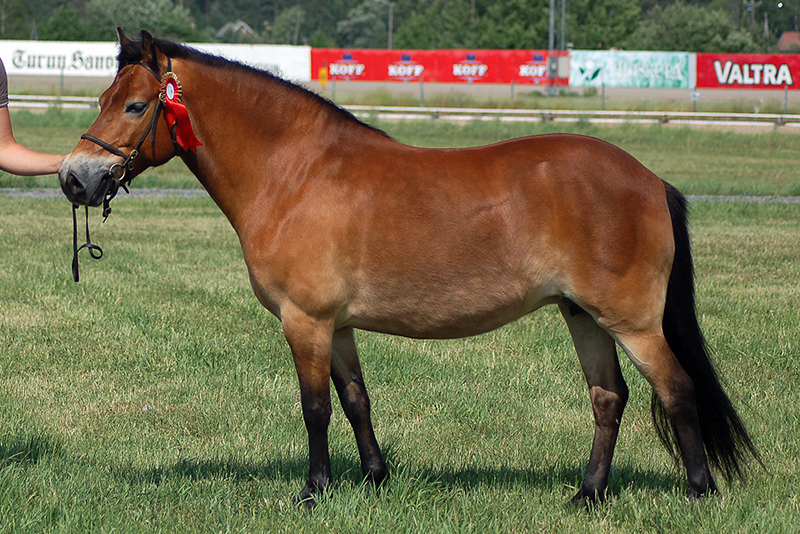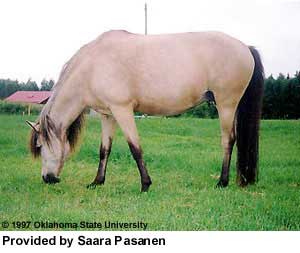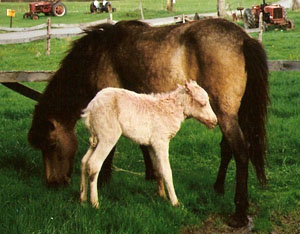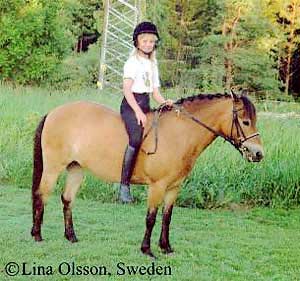Gotland Horses

Also Known By: Skogsruss, Russ, Gotlandsruss, Skogsbaggar, Skogshäst
The herd of ponies at Lojsta moor on the island of Gotland is unique. The Gotland pony, or Russ, as it is called in Sweden, has been called a living relic of the past, and that is precisely what it is. Thanks to decisive intervention on the part of the local inhabitants, Sweden's most primordial horses still live as they have for thousands of years on the wooded moors of Gotland.
The Gotland Pony horses have lived in the forest regions of the island of Gotland from time immemorial. Their history is mysterious and fascinating. Discoveries from the Stone Age show that horses have been present on Gotland for 4,000 - 5,000 years, and perhaps longer. It is not known whether these horses were Gotland Ponies, nor is it known how the first horses came to the island.
 Russ is the Gutnish word for horse. Gotlanders themselves often call the ponies skogsbaggar,
which means "forest rams". It is commonly thought that the Gotland Pony, as other
European horse breeds, is a descendant of the wild Tarpan. There are few ancient references to the Gotland ponies, but it is generally believed
that they lived in freedom in the forests in a half-wild state. Discoveries made at
the Iron Age village called Vallhagar (220 B.C.—500 A.D.), a few kilometers from Lojsta
Moor, show that horses became increasingly common as domestic animals during the Iron
Age.
Russ is the Gutnish word for horse. Gotlanders themselves often call the ponies skogsbaggar,
which means "forest rams". It is commonly thought that the Gotland Pony, as other
European horse breeds, is a descendant of the wild Tarpan. There are few ancient references to the Gotland ponies, but it is generally believed
that they lived in freedom in the forests in a half-wild state. Discoveries made at
the Iron Age village called Vallhagar (220 B.C.—500 A.D.), a few kilometers from Lojsta
Moor, show that horses became increasingly common as domestic animals during the Iron
Age.
The oldest reference to the Gotland pony is found in Skånelagen, a legal code from the 13th century, where "the wild horses of Gotland" are mentioned.
Starting from the 18th century several descriptions of the Gotland Pony can be found. Bishop Joran Wallin wrote in 1776: "As concerns the untamed horses, they run free in the woods both winter and summer, without any tending, feeding themselves as best they can, and are often without owner as well . . . always staying to the woods, even though often, especially in the winter when it is very cold and there is much snow, they can be seen by travelers near the high-ways, as well as in the country villages and the town itself, are of middle size, but look poorly, shaggy, ungroomed, with long manes and hair over their eyes." Botanist Carl Linneus, on his Gotland voyage in 1741, mentioned how special traps were used to capture the horses near the ancient fort called Torsburgen.
 In the beginning of the 19th century the ponies could be found throughout Gotland,
especially in the large forests in the middle of the island. Farmers kept Gotland
Ponies on their farms as draft horses. They often had a herd of free-roving horses
in the forest as well, so they would be able to bring in a new young horse to the
farm when they needed.
In the beginning of the 19th century the ponies could be found throughout Gotland,
especially in the large forests in the middle of the island. Farmers kept Gotland
Ponies on their farms as draft horses. They often had a herd of free-roving horses
in the forest as well, so they would be able to bring in a new young horse to the
farm when they needed.
In the mid-19th century the situation changed; the number of Gotland ponies dropped sharply. Many were sold to England, Germany, and Belgium where they were used for mining and other chores. On Gotland, formerly public lands were parceled out to individual farmers, which meant that more land was farmed and much of the forested area began to be cultivated. The expansive, contiguous forests were intersected by fences and cultivated land and could no longer function as foraging areas. In addition, the ponies caused great damage when they grazed and trampled down the sown fields, and they began to be seen as pests.
 In the beginning of the 20th century only about 150 Gotland ponies were left, but
a few people with foresight had taken note of Sweden's most primitive horse. The Gotland
Pony began to be exhibited at the summer fairs held by the Gotland Agricultural Society,
and a few stud-farms were established to breed the horses. But the number of Gotland
Ponies continued to fall. The meat rationing and food shortages of World War I led
poachers to hunt the Gotland Pony. The forest ponies of Gotland were near extinction.
In the beginning of the 20th century only about 150 Gotland ponies were left, but
a few people with foresight had taken note of Sweden's most primitive horse. The Gotland
Pony began to be exhibited at the summer fairs held by the Gotland Agricultural Society,
and a few stud-farms were established to breed the horses. But the number of Gotland
Ponies continued to fall. The meat rationing and food shortages of World War I led
poachers to hunt the Gotland Pony. The forest ponies of Gotland were near extinction.
Then a few farmers in the communities of Gerum and Lojsta, together with the Gotland Agricultural Society intervened to save the Gotland Pony. They fenced in about 200 acres, the area that now constitutes the winter pasture. There, five Gotland Ponies that had been captured on the moor were let run, together with three other Gotland Ponies that were donated by a stud farm that had gone out of business. In this area the horses were allowed to run free, and soon a little Gotland Pony clan had developed. These horses formed the basis for the breeding that has been carried out at Lojsta Moor in an effort to maintain the stock as pure as possible.
The people who own the Gotland Ponies living on the moor, farmers in the neighborhood together with the Gotland Agricultural Society, have started a grazing cooperative. Thanks to their efforts, there is a free-roaming Gotland Pony herd on Lojsta moor today.
During the part of the year when the foals are still on the moor, the herd consists of seventy to eighty head; about forty breeding mares, some fifteen fillies, and the rest foals. As a rule only mares born on the moor are permitted in the herd. A different stallion is used every third year to prevent inbreeding.
Most Gotland Ponies are blacks, bays, buckskins or sorrels. The light coloring of this foal is not considered desirable. There is a risk that the offspring of two light-colored Gotland Ponies might be an albino, meaning it would lack pigmentation. Horses like this can have skin that is over-sensitive to the sun and are not as hardy.
Just as with other breeds of horses, there are standards for the appearance and characteristics of a Gotland Pony. The desire is to produce an easily-born, strong children's horse that can be used for trotting, dressage, jumping, and driving. Good fertility is also considered important.
For a Gotland Pony to be pedigreed, the height measured at the withers must be between 45 - 51 inches (115 - 130 cm.), while the ideal height is about 49 inches (125 cm.). Its way of going should be energetic, elastic, and smooth. All colors are allowed except for total albinos, drabs, dorsal piebalds, and roans.
The Gotland Pony is popular as a children's horse, good-tempered and multifaceted. The same Gotland Pony can both be a good jumper, dressage horse, and draft horse. The Gotland Pony is also the fastest trotter among ponies. There are about 9,000 Gotland Ponies in Sweden today, and they can also be found in Denmark, Finland, and the U.S.A.
Gotlands are one of the newest breeds in North America, having been first imported only recently. They are used as in Sweden for pony racing, showing, and pleasure riding. Gotlands do well in competitive trail riding and are considering to be exceptional mounts for children.
Status: Minor. It is not known exactly how many Gotlands there currently are in North America.
Registries and Breed Associations
Denmark
Danish Gotlandsruss Breed association
secretary
Signe Kroner
Boserupvej 5
3200 Helsinge
Denmark
Email: engbakke@hotmail.com
Finland
Finnish Gotland Pony Association
Secretary
Aila Kajander
Suomen Russ-ponien Ystävät ry
Lakeansuontie 7
04150 Martinkylä
Finland
Email: aila.kajander1@luukku.com
United States
Gotland Russ Association of North America
811 Carpenter Hill Road
Medford, OR 97510
(541) 535-6756
E-mail: GoGotlands@aol.com
References
American Livestock Breeds Notebook. The Livestock Conservancy PO Box 477, 33 Hillsboro St, Pittsboro, NC 27312. 1989.
Russen på Lojsta hed (The Wild Ponies of Gotland), Haakan Hollstroem, Sweden, translation by Marion Cutting
Mason, I.L. 1996. A World Dictionary of Livestock Breeds, Types and Varieties. Fourth Edition. C.A.B International. 273 pp.
Tomas Gahm, Gotland
